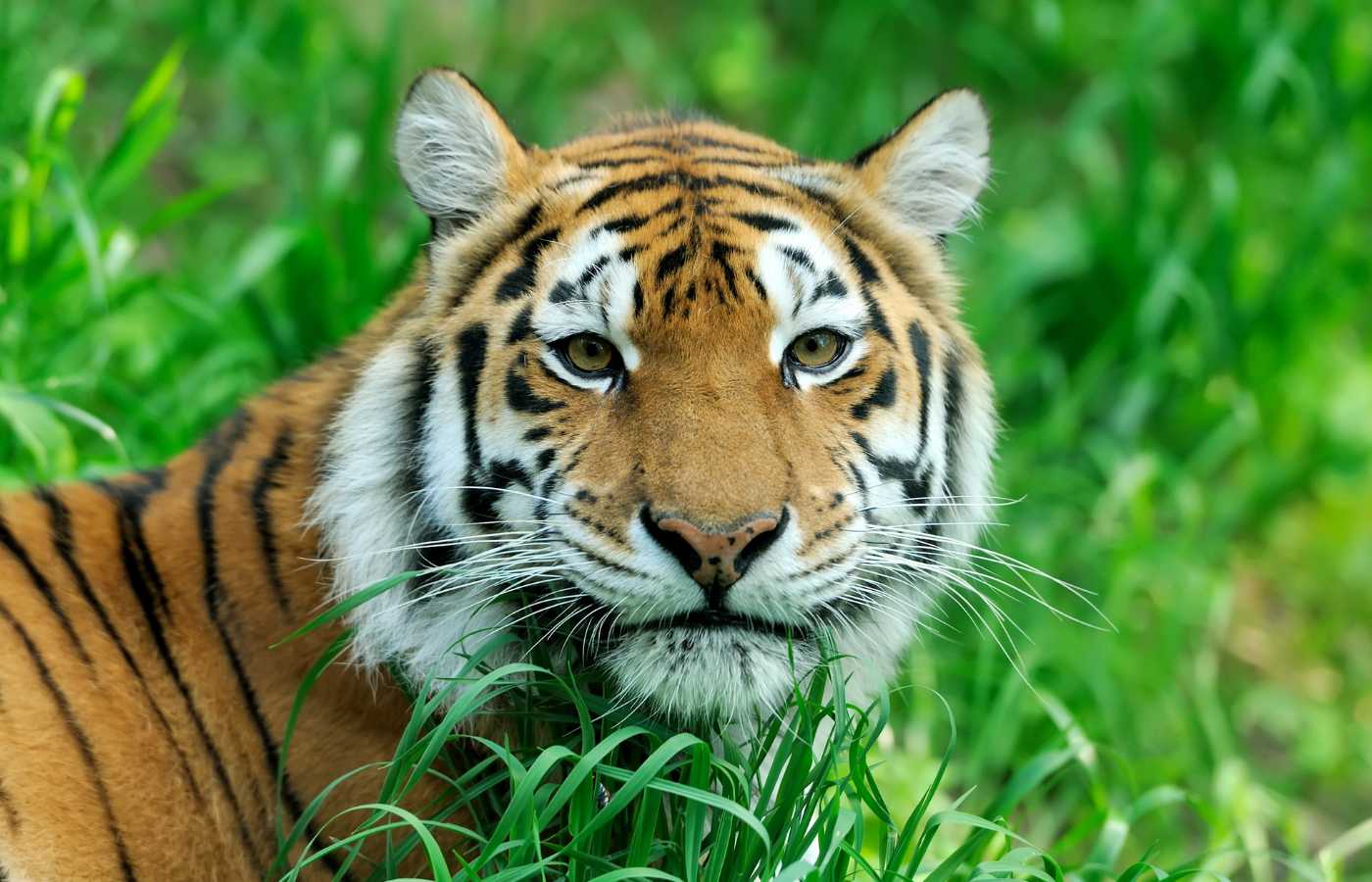International Tiger Day is July 29th, so there’s no better day to learn about White Tigers. These rare animals capture the imagination of humans for their striking white fur and blue eyes.

But what gives them their unique appearance? Are they different from orange tigers? How many of them are left on Planet Earth?
Here are 25 surprising and interesting facts about White Tigers that your kids will love!
Did you know tigers aren’t the only big cats with fascinating stories? Explore more about another stealthy predator in our Black Panther Facts for Kids.
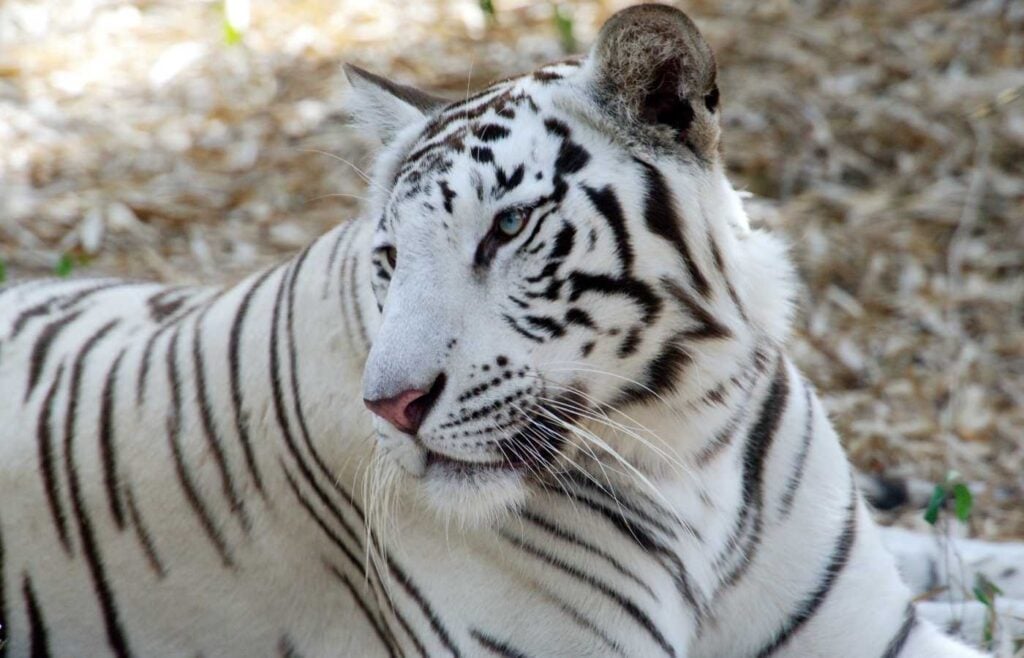
25 Facts About White Tigers
1. White Tigers are not a separate species of tiger.
All white tigers are a colour variation of Bengal tigers. Contrary to popular belief, these large cats are not a separate subspecies of tiger.
There is only one tiger species and six tiger subspecies: the Siberian tiger, the Bengal tiger, the South China tiger, the Sumatran tiger, the Indochinese tiger, and the Malayan tiger.
Similarly, rhinos aren’t all one species. Learn about the different types in our Rhino Facts for Kids.
2. White Tigers are also not Siberian Tigers.
White Tigers are are often confused with Siberian Tigers, because when people think of Siberia, they think of snow. White Tigers are white Bengal Tigers.
3. In the wild, White Tigers are born in 1 in 10,000 births.
White Tigers are only born to parents that both carry the recessive gene for white coloring.
4. White fur is a rare genetic mutation.
Having white fur is the result of a very rare genetic mutation. It is caused by the absence of phenomelanin, a pigment found in normal Bengal tigers with orange fur.
5. White fur makes it harder to survive.
Their white coat is not helpful in the wild. It doesn’t provide the tiger with any camouflage, which greatly reduces their chance of survival.
The white fur reduces their ability to stalk prey or avoid other predators.
Other animals, like red pandas, also have specific adaptations for survival. Learn more in our Red Panda Facts for Kids.
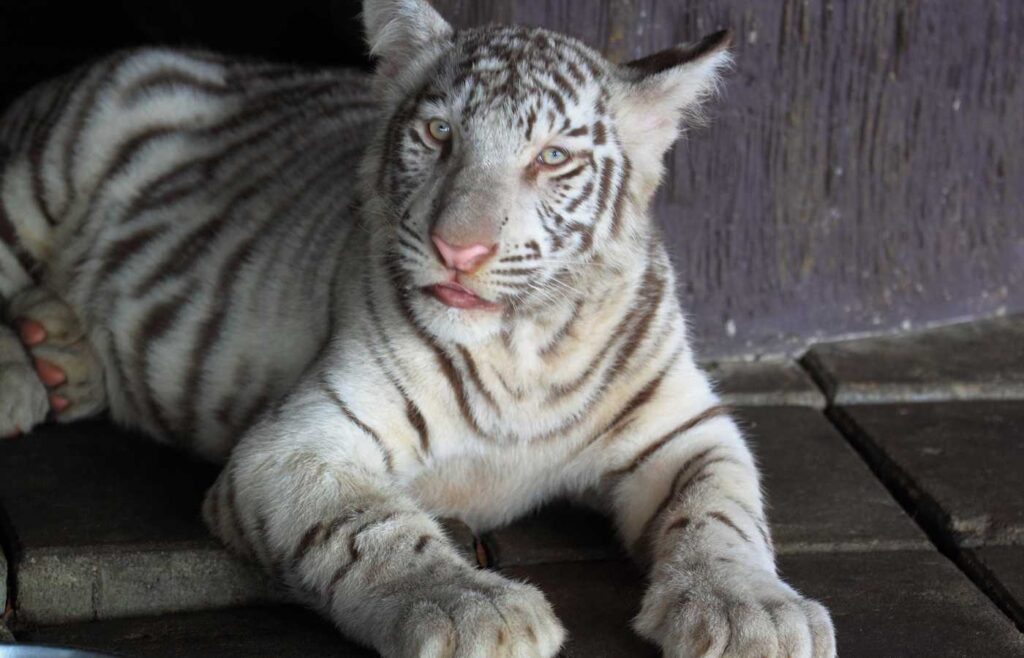
6. White Tigers have blue eyes.
The gene for blue eyes is linked to the gene for white fur. So while most orange Bengal tigers have yellow eyes, white tigers have blue eyes.
7. White Tigers have crossed eyes.
All white tigers have crossed eyes, whether it shows or not.
The gene that causes the white coat always causes the optic nerve to be wired to the wrong side of the brain.
Because their reaction time is diminished, and they are more dependent on their masters because they can’t see clearly, they are a popular choice with tiger performers.
8. White Tigers are slightly bigger than their orange counterparts.
This size difference is noticeable at birth and seems to continue throughout their lifespan. It is probably linked to the same gene that causes their white fur.
9. Adult Tigers can weigh up to 570 pounds.
These large animals can grow to be more than ten feet long!
10. White Tigers can run up to 60 miles per hour.
This powerful animal can run as fast as your car drives on the highway! While white tigers are fast, cheetahs are the ultimate speedsters in the animal kingdom. Learn more about their incredible sprinting abilities in our Cheetah Facts for Kids.

11. White Tigers can eat up 40 pounds of meat in one sitting.
The White Tiger is a carnivorous animal, meaning they hunt, kill, and eat other animals. They use their sharp claws to take down large prey.
Did you know sharks have similarly voracious appetites? Find out more in our Shark Facts for Kids.
12. If you shaved a white tiger, the black stripes are still visible on their skin.
No two tigers have the same pattern of stripes. Their dark stripes are as unique as human fingerprints.
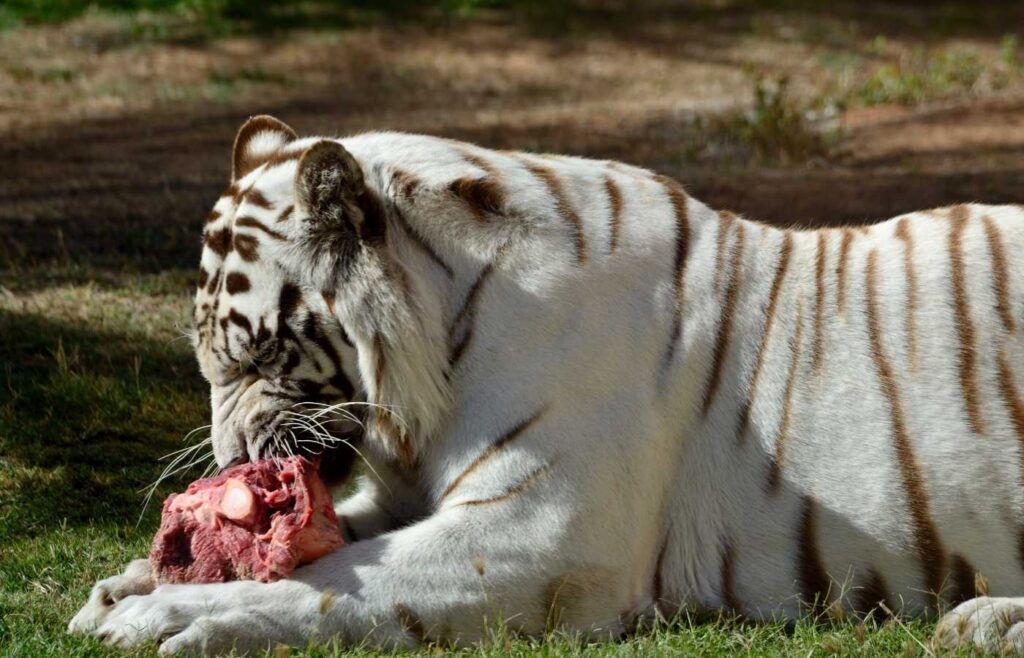
13. White Tigers are solitary animals.
Like all tigers, White Tigers are solitary in their natural environment. They are territorial and like be alone. They do come together to hunt large pray and to mate during mating season.
Monkeys, in contrast, are social animals with fascinating group dynamics. Discover more in our Monkey Facts for Kids.
14. White Tigers need a lot of space.
In their natural habitat, the White Tiger (and all Bengal tigers) would ideally need about 20 square miles of space in which to roam, live and hunt. Captive tigers almost never get this much living space.
15. White Tigers can swim.
Tigers are capable swimmers. Their large webbed paws and muscular bodies help them swim up to seven miles at a time.
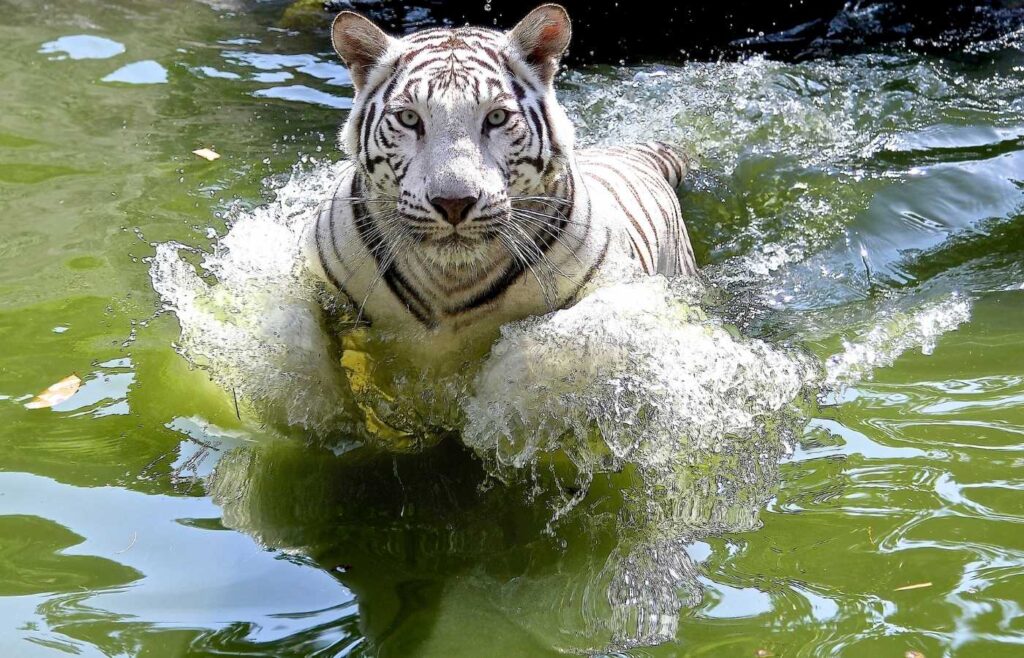
Elephants are also excellent swimmers, using their trunks as snorkels. Check out their aquatic skills in our Elephant Facts for Kids.
15. Their fur can change color.
White Tigers, along with Siamese cats, and Himalayan rabbits, have enzymes in their fur that react to cold temperatures. This causes them to grow darker in the cold.
16. A White Tiger is not an albino tiger.
Contrary to popular belief, a White Tiger is not albino (which is a form that lacks hair and skin color). For a White Tiger to be born, two Bengal tigers with specific recessive genes have to mate.
17. The first recorded sighting of a white tiger was in India between 1561.
The sighting was documented in India in Akbar Nama (a chronicle maintained by the Mughal King Akbar).
18. The first documented case of a White Tiger being captured was in 1915 in India.
He was caught by the local maharaja (an Indian prince) who kept the tiger until its death.
19. Mohan the Cub is the ancestor of all white tigers in the U.S. today.
In 1951 a white tiger cub was captured in India after being orphaned. His mother and three orange siblings were killed.
He was given to the Maharajah of Rewa (an Indian Prince) who named him Mohan.
The Maharaja inbred him with a female tiger to create more white tigers. That means he bred the tiger with close relatives.
Mohini, one of Mohan’s cub, was bought by an American businessman and given to the National Zoo in Washington D.C.

20. Siegfried and Roy performed with White Tigers in Las Vegas.
Siegfried & Roy were German-American entertainers who were best known for performing with White Tigers in Las Vegas. Their performing career ended in October of 2003 when their White Tiger Mantacore attacked Roy on stage during a performance. He survived the incident.
21. There are no known white tigers in the wild today.
Even thought tigers are meant to be wild animals, there are no known White Tigers in the wild today. The last known wild white tiger was killed in 1958 by a trophy hunter. The last known wild white tiger was killed in 1958.
22. Only around 200 white tigers exist in the world today.
All of them live in captivity in zoos, theme parks, or in exotic pet collections. They are all the results of inbreeding.
There are currently no known white tigers in the wild. (Remember, they only occur in one in 10,000 tiger births).
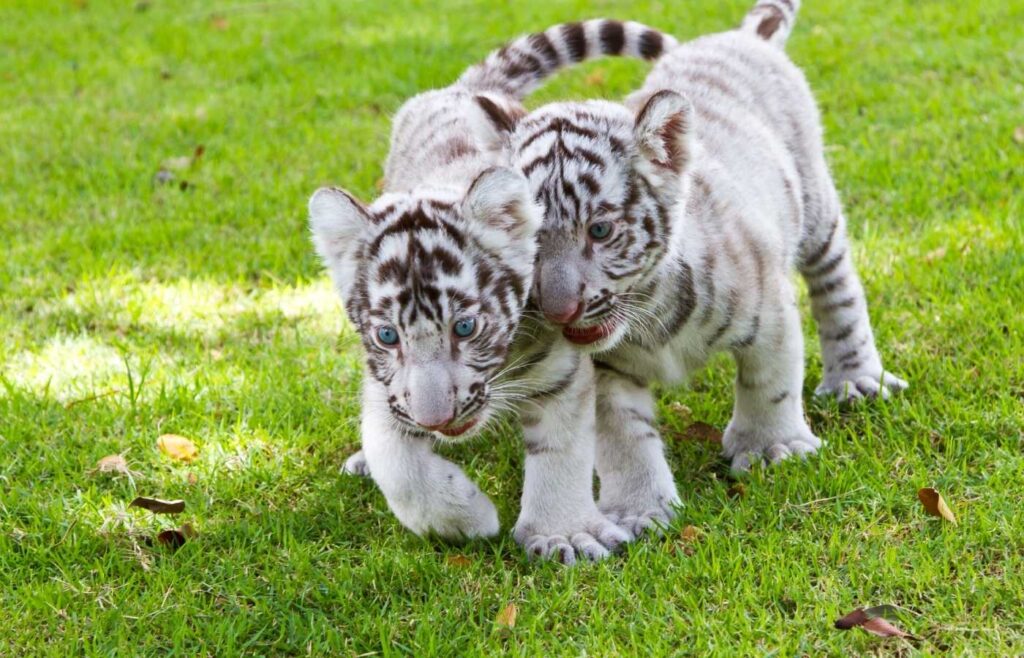
23. Inbreeding is very harmful to White Tigers.
Inbreeding is when the male and female white tigers are bred with close relatives. Humans in the Inbreeding is when the male and female white tigers are bred with close relatives. Humans in the exotic pet trade do this to their captive white tigers in order to sell the cubs to make money for themselves. Humans who own exotic animal farms do this to make money from people who want to take their photo with White Tiger cubs.
Unfortunately, inbreeding is very harmful to White Tigers. It causes many cubs to die shortly after birth. It also leads to lower average life spans and health problems like impaired vision, heart defects, spinal and facial deformities, and weak immune systems.
24. White Tigers are not an endangered species.
Remember, White Tigers are not a separate species. “Conservation” facilities are often exploiting the tigers to make money by charging people to see and take photos with White Tiger cubs.
Tigers are an endangered species. An estimated 3900 tigers are left in the world.
25. A law has been introduced to stop inbreeding and exploitation of white tigers for profit.
Federal legislation has been introduced in the U.S. Senate, including the Big Cat Public Safety Act (H.R. 263/S. 1210), to stop the highly unregulated breeding of big cats.
You can write to congress to express your support of this legislation and help make a difference in the lives of White Tigers.
Read more fun facts about tigers >>
Frequently Asked Questions About White Tigers
Where do white tigers live?
The white tiger is a Bengal tiger born with a rare pigment mutation. Their wild habitat ranges from western India to China and southeastern Asia.
What do white tigers eat?
White tigers are Bengal tigers born with a rare pigment mutation. They are carnivores which means they eat meat. Their diet consists of other large carnivores such as deer, wild boar, cattle and goat.
Are white tigers rare?
Yes. In the wild, White Tigers are born in 1 in 10,000 births. White Tigers are only born to parents that both carry the recessive gene for white coloring.
Are white tigers extinct?
No. Tigers are an endangered species. An estimated 3900 tigers are left in the world. White tigers are Bengal tigers born with a rare pigment mutation. “Conservation” facilities are often exploiting the tigers to make money by charging people to see and take photos with White Tiger cubs.
Are white tigers endangered?
Tigers are an endangered species. An estimated 3900 tigers are left in the world. White tigers are Bengal tigers born with a rare pigment mutation. “Conservation” facilities are often exploiting the tigers to make money by charging people to see and take photos with White Tiger cubs.
Do white tigers exist in the wild?
Yes. In the wild, White Tigers are born in 1 in 10,000 births. White Tigers are only born to parents that both carry the recessive gene for white coloring.
Do white tigers live in the snow?
No. The white tiger is a Bengal tiger born with a rare pigment mutation. Their wild habitat ranges from western India to China and southeastern Asia.
Want more information? Read our full list of fun facts about tigers >>
We hope that this article helped you learn something new and amazing about the White Tiger. These incredible animals deserve our respect and admiration.
Explore more fun facts:
- Black Panther Facts for Kids
- 75 Amazing Cheetah Facts Your Kids Will Love
- 50 Amazing Rhino Facts for Kids
- Red Panda Facts For Kids
- 50 Mind-Blowing Monkey Facts Your Kids Will Love
- 100 Mind-Blowing Facts About Elephants
- Shark Facts for Kids
Calie Herbst, Editor-in-Chief of Milwaukee With Kids, has spent over a decade combining her experiences as a parent of three to create a hub for Milwaukee’s family adventures.
Her decade-long teaching career in Milwaukee Public Schools and academic background, including a Master’s in Teaching from Marquette University and dual B.A.s in Sociology and Spanish from the University of Wisconsin – Madison, fuel her passion for inclusive and engaging family content.
Calie is also a recognized voice in local media, contributing to WISN Channel 12 News, WTMJ Wisconsin Morning News, Fox 6’s Real Milwaukee, and B93.3.
Discover more about Calie’s journey and editorial approach on her About Page and Editorial Policy Page.









